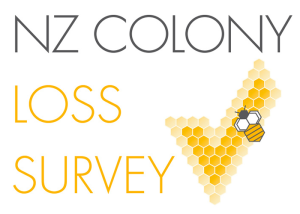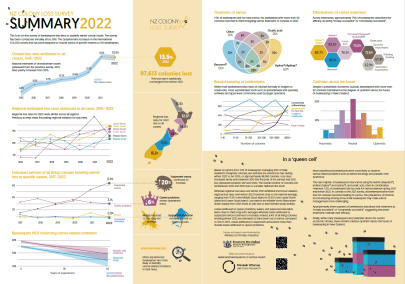2022 Colony Loss Survey
In this section
 Conducted annually since 2015, the New Zealand Colony Loss Survey is based on the survey of beekeepers developed by the international COLOSS honey bee research association.
Conducted annually since 2015, the New Zealand Colony Loss Survey is based on the survey of beekeepers developed by the international COLOSS honey bee research association.
Survey topics include the number and nature of over-winter colony losses, queen health and performance, indicators of diseases and parasites, treatment of Varroa, supplemental feeding, and colony management. Because the challenges facing New Zealand beekeepers differ from those facing beekeepers in the northern hemisphere, the survey also includes questions that are specific to the New Zealand context, e.g. apiary crowding, predation by wasps, and nectar flow from native trees.
In a 'queen cell'
Based on reports from 41% of beekeepers managing 49% of New Zealand’s honeybee colonies, we estimate the overall loss rate during winter 2022 to be 13.5%, or approximately 98,000 colonies. Loss rates increased every year between 2015 (the first year of the survey) and 2021, but plateaued between 2021 and 2022. The overall number of colonies lost fell between 2021 and 2022 due to a smaller national hive stock.
Whereas regional loss rates over winter 2021 exhibited enormous variation, regional loss rates over winter 2022 hovered close to the national average, ranging from 11.5% in the Middle South Island to 15.5% in the Upper North Island and Lower South Island. Loss rates in the Middle North Island were down sharply from 2021 levels, in part due to less intensive wasp activity.
Losses attributed to queen problems, wasps, and suspected starvation were close to their long-term averages whereas losses attributed to suspected varroa continued to increase. Indeed, 6.4% of all living colonies entering winter 2022 are estimated to have been lost to varroa compared to 1.6% in 2017. Losses attributed to suspected varroa were more than double losses attributed to queen problems.
More experienced beekeepers were more likely to observe varroa-related problems such as deformed wings and parasitic mite syndrome.
The vast majority of beekeepers treat varroa using flumethrin (Bayvarol®), amitraz (Apivar® and Apitraz®), and oxalic acid, often in combination. However, 1.5% of beekeepers did not treat for varroa between spring 2021 and winter 2022. In contrast to the 2021 survey, all beekeepers with more than 50 colonies reported treating for varroa. The prevalence of informal record keeping among some small beekeepers may make varroa management more challenging.
Approximately three-quarters of beekeepers described their treatment as “mostly successful” or “completely successful”, suggesting that these treatments maintain their efficacy.
Finally, while many beekeepers are pessimistic about the current economic climate, there remains cautious optimism about the future of beekeeping in New Zealand.
Summary












2022 overwinter losses












Varroa














2021/22 Season




























